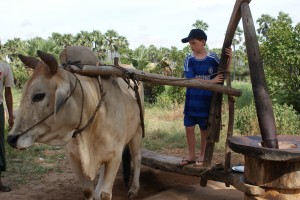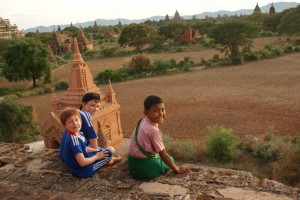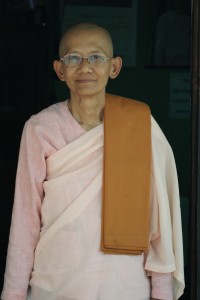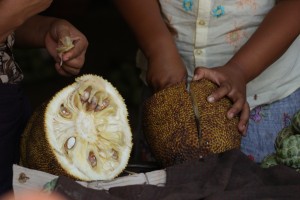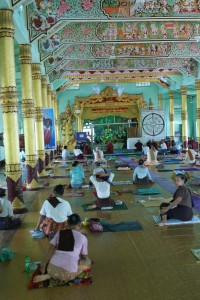The following day we set out for Mount Popa. Mount Popa is a volcanic plug, with a temple on top. Volcanic plugs look like huge rocks jutting out of the earth, and like every other high point in Burma, it has a temple. Mt Popa is infamous for its monkeys, so we were somewhat anxious about how the trip would go. Mt. Popa is however, famous for being the home of the Nats. The Nats are an integral part of religious belief in Myanmar and date back to pre-Buddhist animist days. The Nats are spirits, and are believed to be found everywhere – mountains, streams, stones etc. When Buddhism arrived in Myanmar, it co-opted the existing belief in Nats, who are still worshipped. They take human form, and each one has its own particular story. Throughout Myanmar, in addition to Buddhist festivals there are Nat festivals, and belief is very strong.
Min joined us for our day trip as our guide. Bagan, being in the “dry zone” is intensely farmed, but you don’t see any rice paddies. Rather, you see many ground crops (peanuts especially) as well as toddy plantations. The toddy palm is farmed for its coconut water which is distilled into wine and spirits. We stopped at a plantation, where we saw the whole amazing process. Someone scampered up a tree, collected toddy water, and then we visited the distillery (and tasted the results). We also learned about the other forms of agriculture. The kids loved taking turns at “operating” the bullock, used in the production of peanut oil. Travel is an incredible education for kids – growing up in the city, all they see are products on supermarket shelves, and here they were actually taking part in a process thousands of years old. Jaggery (a candy made from the palm) is also produced and we were given as many samples as we wanted. One of the workers made toys for the kids from palm leaves – as a gift! On the way, We stopped at a dam, where we saw many women and girls collecting and carrying water. Women still do much of the toughest work in Myanmar, and many villages have no running water. It looked like seriously hard work.
Mt. Popa is amazing to see, from afar. As we arrived, we could see legions of monkeys all over the place and Gal became terrified. A roof has been built over the stairway leading to the top, but it doesn’t really keep the monkeys out. Some were very aggressive and luckily Min had brought a large walking stick to keep them away. Afterwards, we stopped in at the local fruit market and bought a jackfruit, a tropical Asian fruit which we hadn’t tasted before. It was huge, and it took three women to peel and cut it for us. Tasty, but there was no way we could eat it all.
Min took us to the local monastery where he has spent time meditating, to meet the monks and nuns. Monasteries are a daily part of life in Myanmar. Firstly, every boy and girl is sent to spend some time in a monastery when they are a child. It is very expensive for poor families – they have to provide the clothes, sleeping bag, bowl and more, but is a sign of how integral Buddhism is to life in Myanmar. How long they wish to spend is up to the child. The monasteries provide schooling and run medical clinics as well. The monasteries are also visited daily by many people in their 60’s and up – it is often how they spend every single afternoon. They can eat there and they can sleep there, for free. We were told that nobody needs to go hungry in Myanmar as the monasteries will provide, and we didn’t see beggars on our trip. The monasteries have always looked after people in need and as a result monks have often been at the forefront of political demonstrations in Myanmar as well. The last huge uprising against the military government was begun by monks. The government had apparently raised the cost of fuel dramatically, leading to transport shortages and food shortages. The monasteries had not been able to feed the people, leading to an uprising.
Our visit was incredible. We met the head monk who welcomed us to eat something with him, and then the table was piled high with food – much more than we could ever eat. We were shown the meditation hall, watched the prayers, visited the clinic and met the head nun, a wonderful dignified lady, who has dedicated her life to Buddhism.
Back in Bagan, we stopped in at another village soccer match before ending our day at the temples. This time we headed to a temple off the tourist track – not the biggest or the most spectacular, but we were there without a bunch of other tourists, which made it so special. As we arrived, a boy dressed in his school uniform approached Daniel and Eitan and they began to play together. He explained in his limited English that he was Zozo, and he climbed up the temple with us. The kids had a great time together. It turned out that Zozo, while wanting to make friends, also wanted to sell us his picture of Bagan. But this wasn’t a photograph or anything commercial – this was his own picture, that he had drawn himself with crayons, of the Bagan temples through his own ten-year old eyes. It was so charming and so innocent and we happily bought it. It is one of our most prized purchases from Myanmar. Not only is it lovely, but it’s a memory of Zozo as well and the kids love it.
(PS: I am now custom-designing trips to Myanmar – click here for more details).
